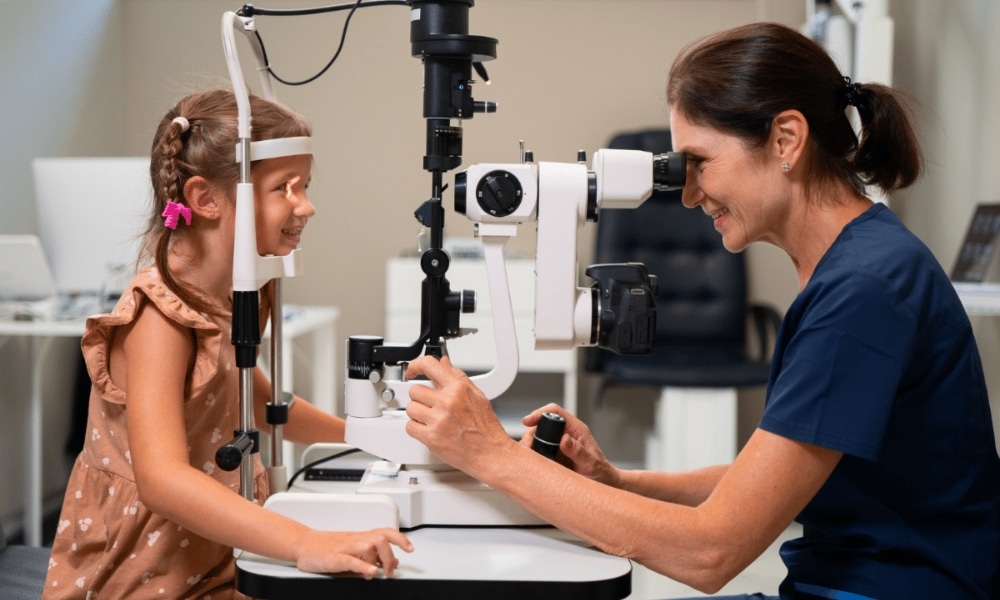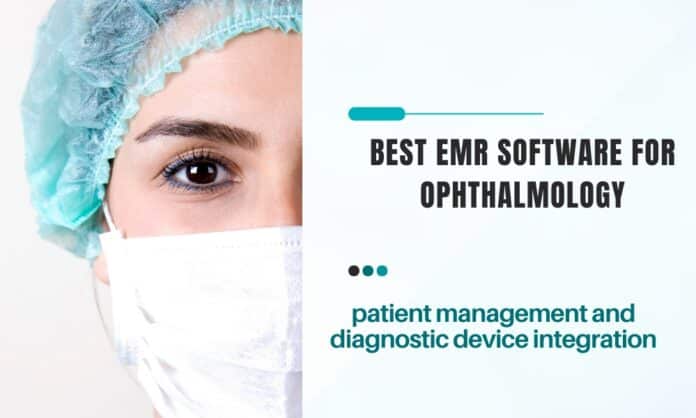In ophthalmology, choosing the best EMR software plays a crucial role in transforming how eye care practices manage patient data, documentation, and overall workflow. Selecting the right software is not just about technology, but about improving patient care, increasing practice efficiency, and ensuring compliance with all healthcare regulations. The best EMR software for ophthalmology offers specific features designed to meet the needs of ophthalmologists, such as specialized templates for exams, seamless image integration, and smooth patient management tools.
This article provides a detailed review of the top EMR software for ophthalmology. We will dive into each option’s key features, benefits, and considerations, helping ophthalmology practices find the right solution that best meets their needs and enhances overall practice management.
Top EMR Software Solutions for Ophthalmology

1. EyeMD EMR: Built for Ophthalmology Practices
EyeMD EMR is a comprehensive, cloud-based EMR system specifically designed for ophthalmology practices. It provides an intuitive and customizable platform that integrates patient management, billing, and image storage. EyeMD EMR stands out for its ease of use, specialized ophthalmology features, and the ability to adapt to the specific needs of an eye care practice. This software helps streamline daily tasks and improve patient care.
Key Features:
- Ophthalmology-Specific Templates: The system includes custom templates for retina, cornea, glaucoma, and other subspecialties.
- DICOM Imaging Integration: EyeMD seamlessly integrates DICOM images, making diagnostic images and tests easier to manage.
- User-Friendly Interface: Designed with simplicity in mind, EyeMD EMR reduces the learning curve for staff, allowing them to adapt quickly.
Benefits:
- Enhanced Workflow Efficiency: It streamlines documentation, reducing the workload for administrative staff.
- Improved Patient Care: Real-time access to comprehensive patient records helps practitioners offer informed and personalized care.
- Specialized Customer Support: EyeMD offers customer support designed for ophthalmology, ensuring that practitioners receive relevant and knowledgeable assistance.
Considerations:
- Learning Curve: While it is user-friendly, the specialized features of EyeMD may require some initial training for full effectiveness.
- Integration Needs: Ensure compatibility with your current practice management system to avoid disruptions during the transition.
2. Nextech IntelleChartPRO: A Complete EHR Solution for Ophthalmologists
Nextech’s IntelleChartPRO is a powerful EMR and practice management system tailored specifically for ophthalmology. It blends cloud-based functionality with extensive features for patient care, billing, and scheduling. With its scalability and customization options, IntelleChartPRO is suitable for ophthalmology practices of all sizes, whether small or large.
Key Features:
- Customizable Charting: This feature allows ophthalmologists to design and adjust charting templates according to their specific needs.
- Integrated Billing and Scheduling: Combines scheduling, patient intake, and billing into one seamless system to improve efficiency.
- Patient Portal: Offers patients access to their health records, appointment scheduling, and secure communication with their care team.
Benefits:
- Improved Patient Engagement: The patient portal fosters better communication and involvement in healthcare.
- Operational Efficiency: Integrated scheduling and billing tools simplify administrative tasks, reducing overhead.
- Regulatory Compliance: Nextech ensures compliance with important regulations, such as HIPAA and Meaningful Use.
Considerations:
- Cost: The premium features offered by Nextech come at a higher price point, which might be prohibitive for smaller practices.
- Customization: The initial setup may require extensive customization to align the system with a practice’s unique workflow.
3. Medflow EMR: A Documentation-Focused Solution for Ophthalmology
Medflow EMR is an EMR solution built specifically for ophthalmology. It combines easy-to-use documentation features with seamless integration of diagnostic imaging, allowing ophthalmologists to manage patient data more efficiently and accurately. Medflow simplifies the patient care process by helping practices capture precise documentation while maintaining a high standard of clinical care.
Key Features:
- Ophthalmology-Specific Templates: Offers templates for cataract surgeries, glaucoma management, and retinal imaging.
- Diagnostic Imaging Integration: Integrates directly with ophthalmic imaging devices, streamlining patient record management and image storage.
- Patient Portal: Provides a patient portal for scheduling appointments, filling out online forms, and securely communicating with the practice.
Benefits:
- Accurate Documentation: Templates designed specifically for ophthalmology help ensure accurate, consistent documentation of patient data.
- Seamless Imaging Integration: By integrating diagnostic imaging directly into patient records, Medflow improves workflow efficiency and reduces the chance of errors.
- Better Patient Interaction: The portal makes it easy for patients to interact with the practice, improving their overall experience.
Considerations:
- Complexity: Some users report that Medflow’s advanced features can be overwhelming at first.
- Integration: Integrating Medflow with non-ophthalmology-specific systems may require additional support and assistance.
4. Modernizing Medicine EMA: Adaptive EHR for Ophthalmology
EMA by Modernizing Medicine offers an adaptive EHR solution designed to improve ophthalmology workflows. With its learning engine, EMA adapts based on user input, allowing it to reduce documentation time over time. This adaptive system is ideal for practices that want to streamline their operations while improving the quality of care provided.
Key Features:
- Adaptive Learning Engine: EMA learns from user preferences and adapts to reduce documentation time and improve efficiency.
- iPad and Cloud-Based Access: Accessible on iPads and through cloud platforms, allowing for mobility and flexibility for ophthalmologists on the go.
- Quality Reporting Tools: Provides robust reporting tools that help practices improve care and meet performance goals.
Benefits:
- Reduced Documentation Time: EMA’s adaptive features streamline charting, significantly cutting down the time required for documentation.
- Support for Value-Based Care: The quality reporting tools support practices in adopting value-based care models, improving patient outcomes.
- Mobile Access: The cloud-based design allows ophthalmologists to access patient records from anywhere, providing greater flexibility.
Considerations:
- Initial Setup Cost: The advanced features of EMA come at a higher price, which might be difficult for smaller practices.
- Learning Curve: While the system is adaptive, it does require some initial training to fully utilize its capabilities.
5. CureMD: Integrated EMR and Practice Management for Ophthalmology
CureMD is a cloud-based EMR system that offers an integrated solution for ophthalmology practices. The system combines electronic health records, practice management, and patient engagement tools, streamlining all aspects of practice operations into one efficient system.
Key Features:
- Custom Ophthalmology Templates: CureMD provides specialized templates for ophthalmic procedures, making it ideal for eye care practices.
- Diagnostic Tool Integration: The platform integrates smoothly with diagnostic tools, making it easier to access patient images and data.
- Telemedicine Capabilities: CureMD includes telehealth options, enabling virtual consultations with patients.
Benefits:
- All-in-One Solution: Integrates patient records, scheduling, and billing, making practice management more efficient.
- Telemedicine Integration: The inclusion of telehealth options allows practices to meet modern healthcare needs.
- Cost-Effective: CureMD offers an affordable solution for ophthalmology practices seeking an all-in-one system.
Considerations:
- Customization Time: Customizing the system to suit the practice’s specific needs may take some time.
- Customer Support: Some users report slower response times from customer support.
Conclusion: Choosing the Best EMR Software for Ophthalmology
Choosing the best EMR software for ophthalmology is a major decision that directly affects patient care and practice efficiency. Specialized EMR systems for ophthalmology provide features that general EMR solutions often lack, such as customizable templates for eye exams, seamless integration with diagnostic images, and tailored patient management tools.
Each software solution has its pros and cons. Practices must carefully evaluate their specific needs before choosing a system. Factors such as ease of use, cost, integration capabilities, and specialized features should guide the decision. By considering these elements, ophthalmologists can select the EMR solution that supports both high-quality patient care and efficient practice management.
Please note that this article is intended solely for informational purposes and does not serve as an endorsement of any specific software.
User Experience-Based FAQs on EMR Software for Ophthalmology
Selecting the right Electronic Medical Record (EMR) software is essential for ophthalmology practices aiming to enhance efficiency, improve patient care, and streamline operations. Insights from current users provide valuable perspectives on different EMR systems. Below are ten frequently asked questions based on user experiences.
1. How does EyeMD EMR enhance practice management efficiency?
EyeMD EMR improves practice management by offering customizable features and seamless integrations. Users find its ability to adapt to specific practice needs especially helpful. It simplifies workflows and reduces the administrative load, making daily operations smoother.
Sources: emrfinder.com
2. What are the strengths of Nextech’s IntelleChartPRO in ophthalmology practices?
Nextech’s IntelleChartPRO is highly praised for its intuitive user interface and efficient charting workflows. It integrates well with diagnostic devices, making it easier to manage patient data. These features contribute to better patient care and improved operational efficiency.
3. How does Medflow EMR support ophthalmology-specific documentation needs?
Medflow EMR offers specialized templates designed for ophthalmic procedures. These templates help improve documentation accuracy. Users also appreciate how it integrates with diagnostic imaging systems, ensuring a complete and organized patient record.
4. What benefits does Modernizing Medicine’s EMA provide to ophthalmologists?
EMA by Modernizing Medicine personalizes the user experience through its adaptive learning engine. This feature streamlines documentation and reduces time spent on charting. Its mobile accessibility gives ophthalmologists flexibility to access records anywhere, improving workflow in various settings.
5. How does CureMD EMR cater to the unique needs of ophthalmology practices?
CureMD EMR offers customizable templates and integrates well with ophthalmic diagnostic tools. Its telemedicine capabilities stand out, allowing ophthalmologists to provide virtual care, which enhances patient engagement and extends service offerings.
6. What user feedback highlights the effectiveness of EyeMD EMR’s customer support?
EyeMD EMR is praised for its responsive and knowledgeable customer support team. One user mentioned, “They are very responsive, compassionate, and persistent,” emphasizing the company’s dedication to user satisfaction.
7. How does Nextech’s IntelleChartPRO facilitate integration with diagnostic devices?
Nextech’s IntelleChartPRO is known for its seamless integration with various diagnostic devices. This feature simplifies the management of patient data, reducing the need for manual data entry and enhancing workflow efficiency.
8. What are the customization capabilities of Medflow EMR for ophthalmology practices?
Medflow EMR offers extensive customization options. Practices can tailor templates and workflows to fit their specific needs. This adaptability helps improve efficiency and ensures the system aligns with the unique requirements of the practice.
9. How does Modernizing Medicine’s EMA support value-based care initiatives?
EMA provides robust quality reporting tools that help ophthalmology practices participate in value-based care initiatives. These tools allow practices to monitor care quality, align with industry standards, and ultimately improve patient outcomes.
10. What aspects of CureMD EMR contribute to improved patient engagement?
CureMD EMR improves patient engagement with its integrated patient portal. This feature allows secure communication, appointment scheduling, and access to health records. Users appreciate how it helps build better patient-provider relationships and boosts patient satisfaction.
Check out: Best Optometry EMR Software for Patient Care and Efficiency

